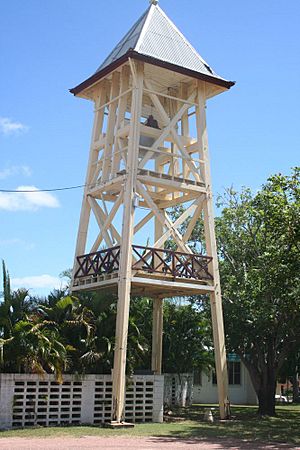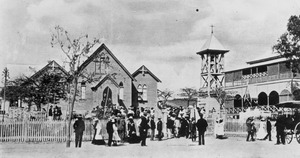St Columba's Church Bell Tower facts for kids
Quick facts for kids Bell Tower, St Columba's Church |
|
|---|---|

St Columba's Church Bell Tower, 2008
|
|
| Location | 134 Gill Street, Charters Towers, Charters Towers Region, Queensland, Australia |
| Design period | 1870s - 1890s (late 19th century) |
| Built | 1897 - 1898 |
| Architect | Charles William Smith |
| Official name: Bell Tower, St Columba's Church | |
| Type | state heritage (built) |
| Designated | 21 October 1992 |
| Reference no. | 600399 |
| Significant period | 1897-1898 (fabric) |
| Lua error in Module:Location_map at line 420: attempt to index field 'wikibase' (a nil value). | |
The Bell Tower of St Columba's Church is a special, historic bell tower in Charters Towers, Queensland, Australia. It belongs to the Catholic Church and is located at 134 Gill Street. The tower was designed by Charles William Smith and built between 1897 and 1898. It was added to the Queensland Heritage Register on October 21, 1992. This means it is a protected and important old building.
Contents
What is the Bell Tower of St Columba's Church?
The bell tower is made of strong wooden beams. These beams sit on a concrete base. Inside the tower, there is a large bell made by a company called Burns & Oats. The tower was built in 1897. It was likely designed by Charles William Smith. He was also the architect for the church building that used to be there.
Early Church Buildings in Charters Towers
When gold was found in Charters Towers in 1872, the Catholic Church started building churches. They built temporary churches in Charters Towers, Queenton, and Millchester. A priest named Father Dunham was the first to serve these churches. But he left within a year.
St Columba's church was first built in Queenton. For some years, priests only visited it now and then. Father Denis Houhy became the first full-time priest there in 1876. Gold mining grew in the area. So, in 1878, the church bought new land on Gill Street. The church building from Queenton was moved to this new spot. But a big storm in 1879 destroyed it. A new church was built in 1880. Parts of the old church were used to build a school.
Building a New Bell Tower and Church
In 1890, a new and very active priest, Father Comerford, arrived. He saw that the church buildings were old and falling apart. He started a big building plan. The school and church were made bigger. A beautiful new convent was built for the Sisters of Mercy. They had been living in very simple homes.
In 1893, Father Comerford began collecting money for a new bell tower and bell. The bell was ordered from a company in London called Burns and Oats. It cost £210. The tower to hold the bell was built in 1897-1898. It cost £325/17/3.
At this time, the church itself was also being changed and made bigger. Charles William Smith designed these changes. He was a partner in the company W.G. Smith & Sons. The cost for the bell tower included fees for an architect. This means Charles William Smith probably designed the tower too. Both the new church and the tower were finished in 1898. The new church could hold 1000 people.
A Time of Growth and Prosperity
All the building work in the 1890s cost a lot of money, about £9,900. This included smaller things like offices and stables. The church facilities were "far surpassing anything in North Queensland" at that time. Most of the cost was paid off by the end of the 1890s. This was amazing because it was a time of financial trouble in Australia. It showed how much the church members supported the project. It also showed how rich Charters Towers was because of gold. In 1902, the bell tower's wooden frame was made stronger. In 1923, its concrete base was also reinforced.
In 1973, the National Trust of Queensland listed St Columba's church, the presbytery (priest's house), and the bell tower as important. Today, the bell tower is the only building left from the original church complex built in the 1800s. When a new church was built in 1974, the tower was repaired and painted. At that time, the wooden boards that covered the bottom of the tower were removed. The stairs that led to the bellringer's platform were also taken away. The platform now has a criss-cross railing instead of the old wooden dowels.
What Does the Bell Tower Look Like?
The bell tower is made of large, painted wooden beams. It has four main legs that are made stronger by criss-cross beams. The tower has a very steep, pointed roof that looks like a pagoda. A cross sits on top of the roof. Small decorations are on the corners of the roof. The roof is covered with corrugated iron.
Inside the tower hangs the big bell made by Burns & Oats. There is a platform where the bellringer used to stand. It has a criss-cross railing. However, there are no stairs to reach it now. The legs of the tower are now open and visible. The tower is very tall and can be seen from many streets away. It is a well-known landmark in Charters Towers.
Why is the Bell Tower Important?
The Bell Tower of St Columba's Church was added to the Queensland Heritage Register on October 21, 1992. This means it is important for several reasons.
Showing Queensland's History
The bell tower is the last building left from a very important church area in Charters Towers. It shows how the Catholic Church grew in North Queensland. It also shows how rich and important the Charters Towers goldfield was in the 1800s.
Its Beautiful Design
The bell tower has been a landmark in the city since 1897. Its huge wooden frame reminds people of a time when the Charters Towers landscape had many other wooden towers. These towers held the machinery for the gold mines.
Its Connection to the Community
St Columba's bell tower is important because of its long history with the local church community. It is the only building from the 1800s that remains on a site that has had Catholic Church buildings since the 1870s.


